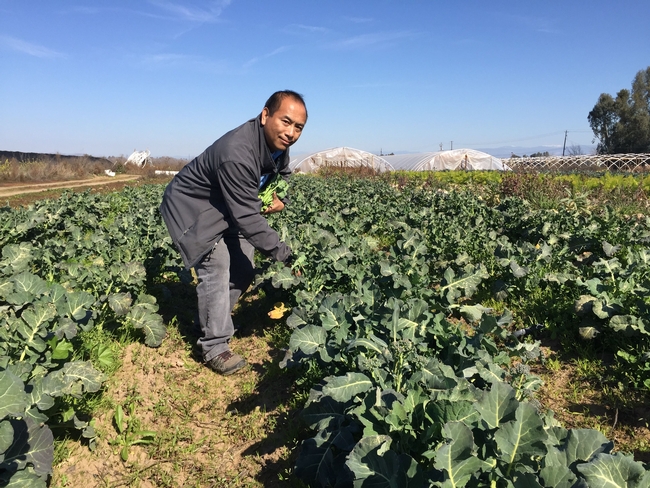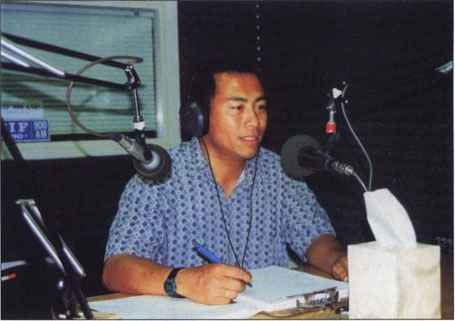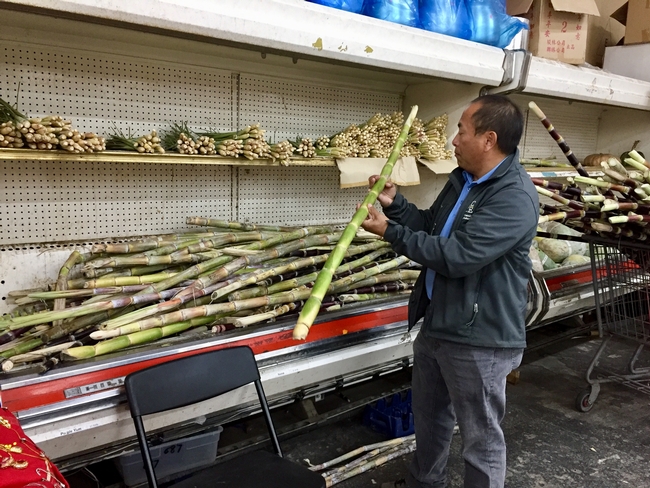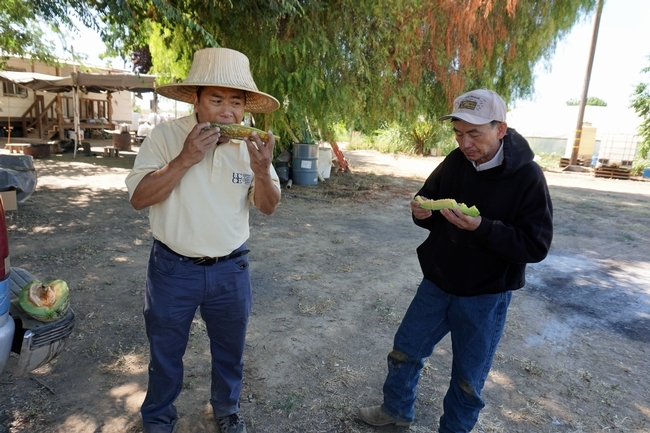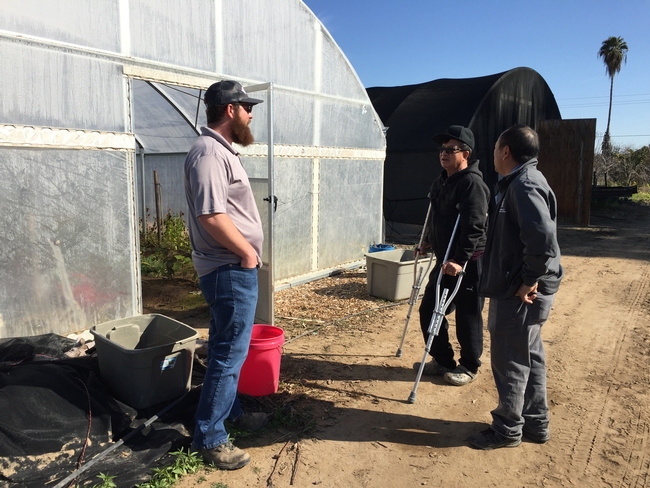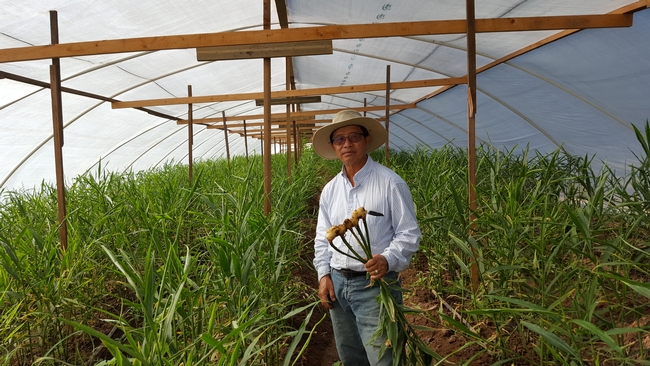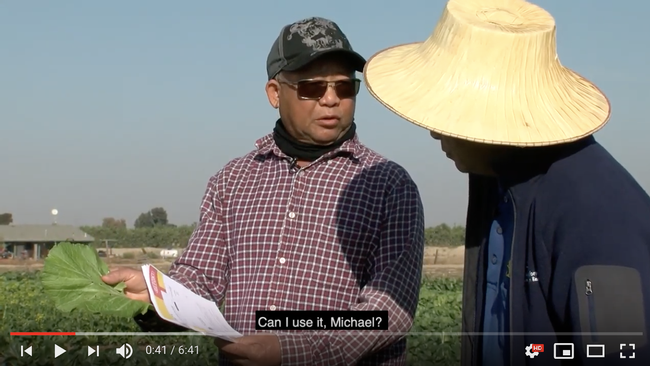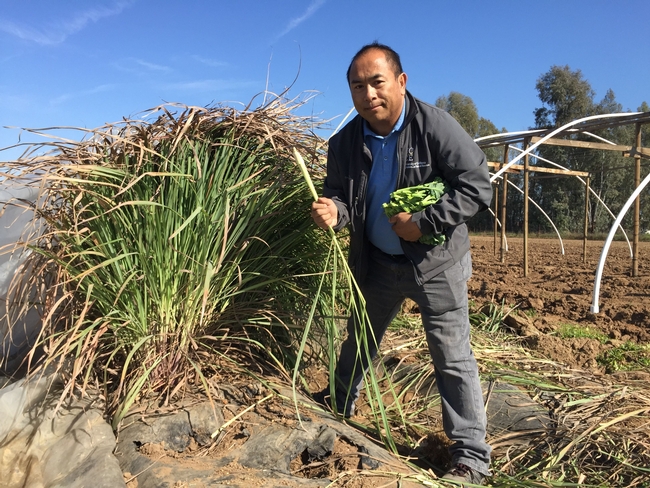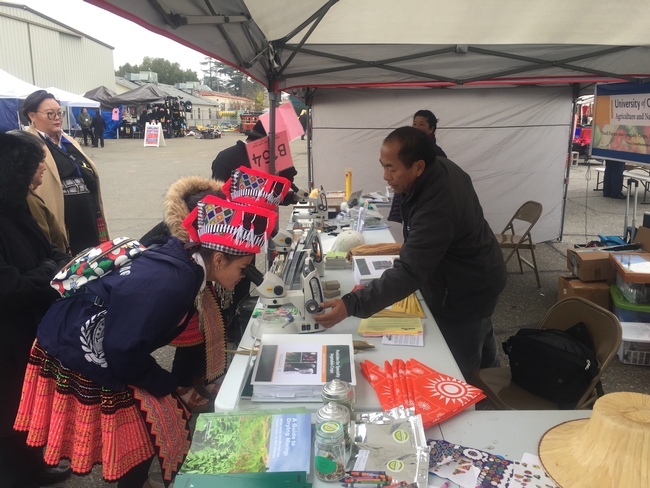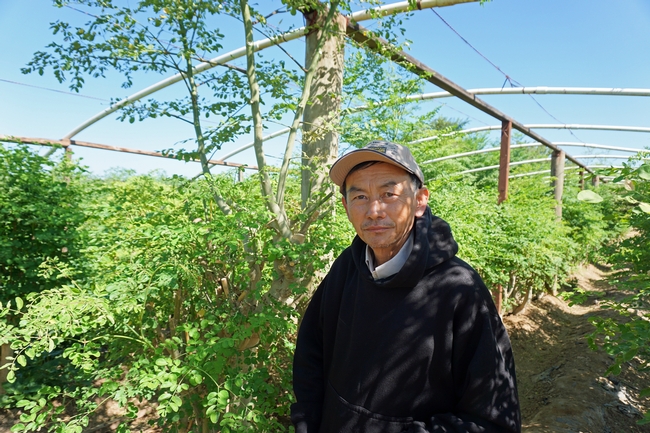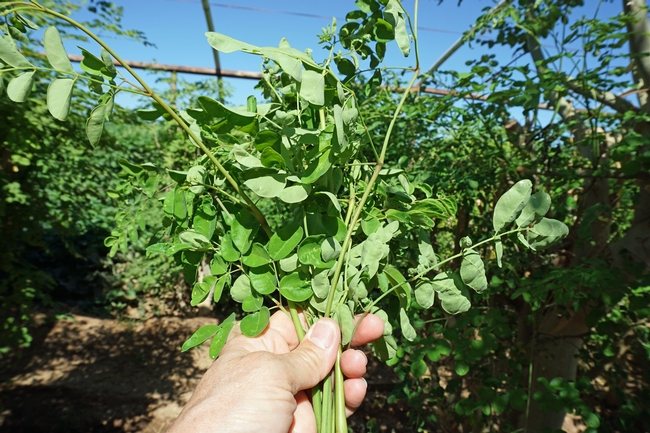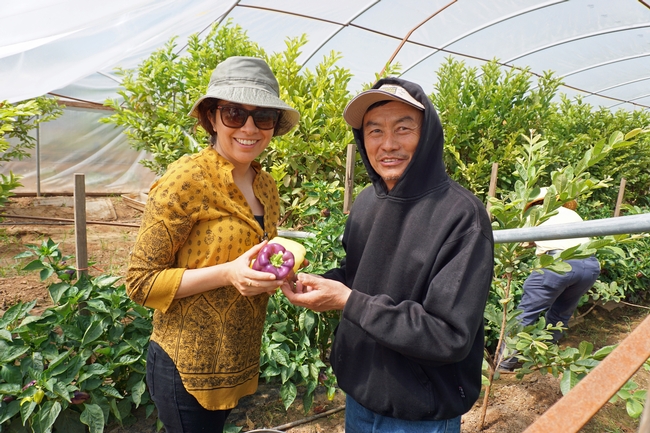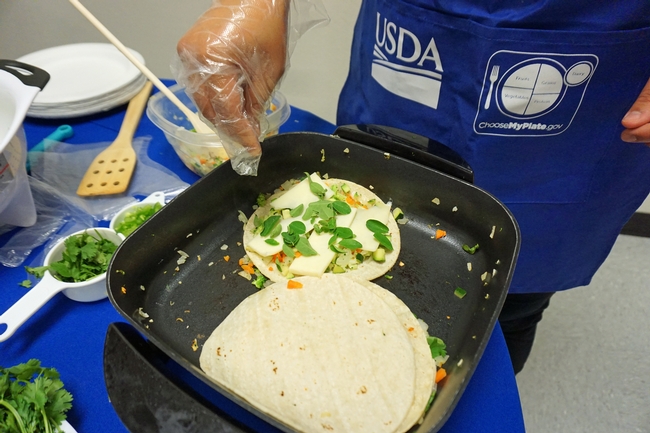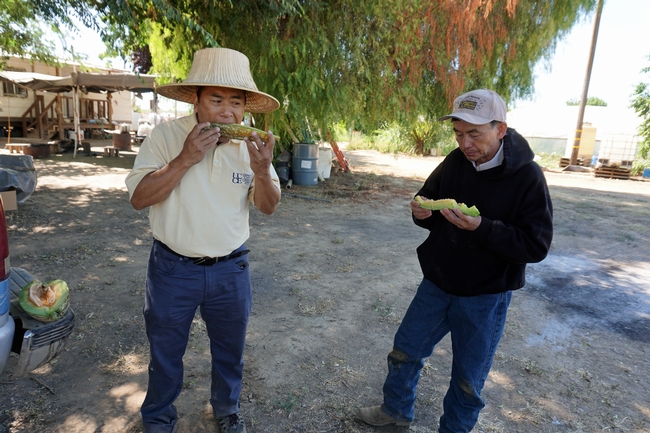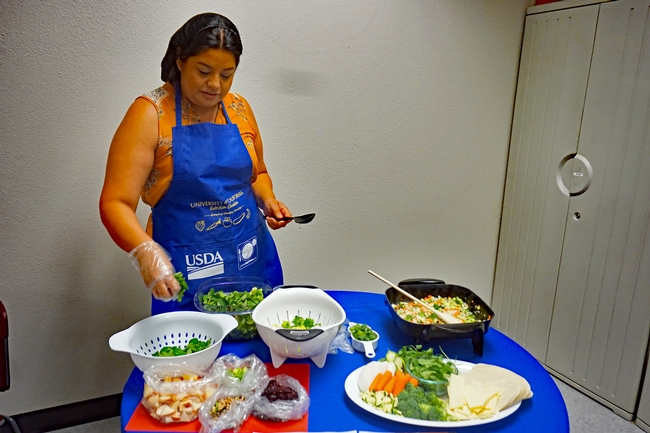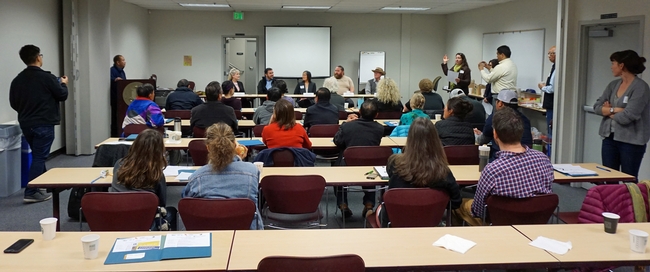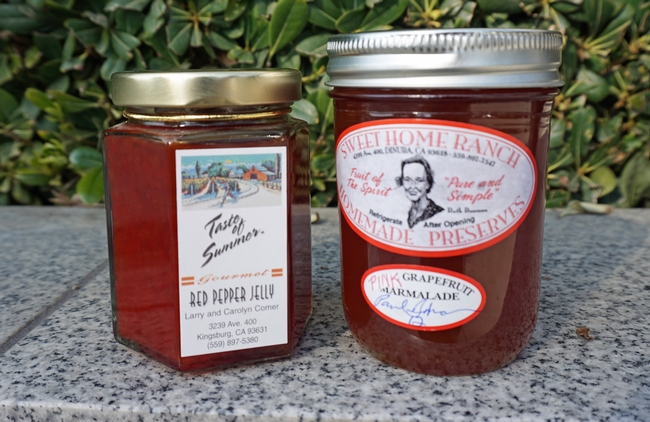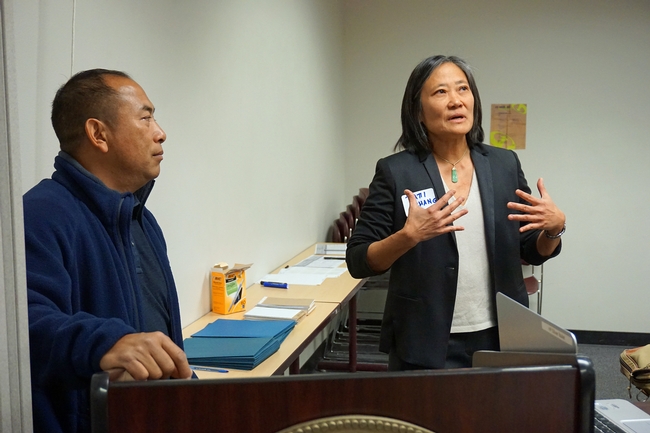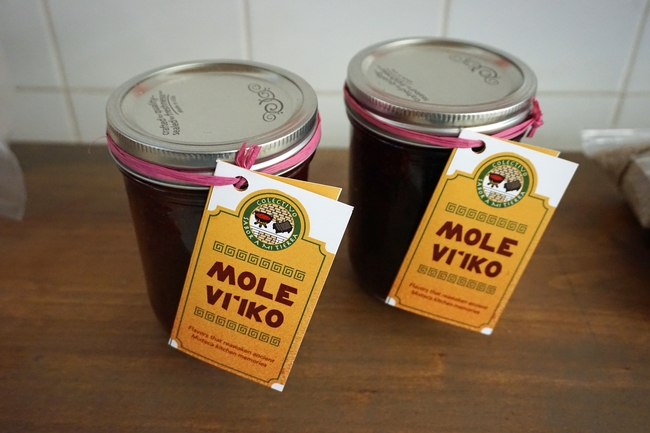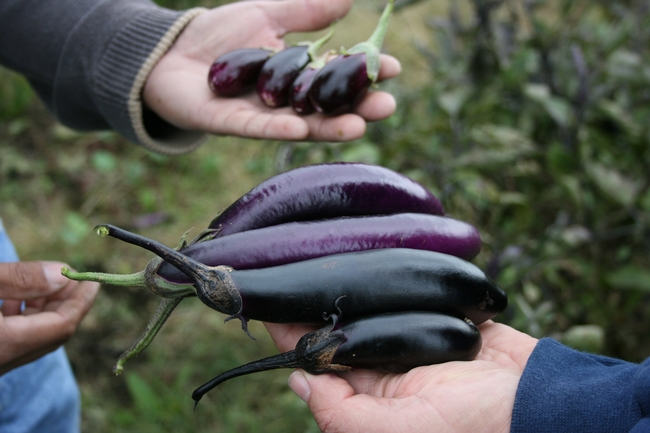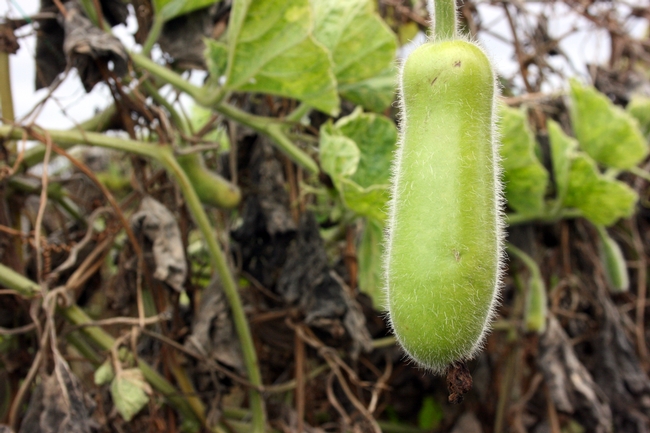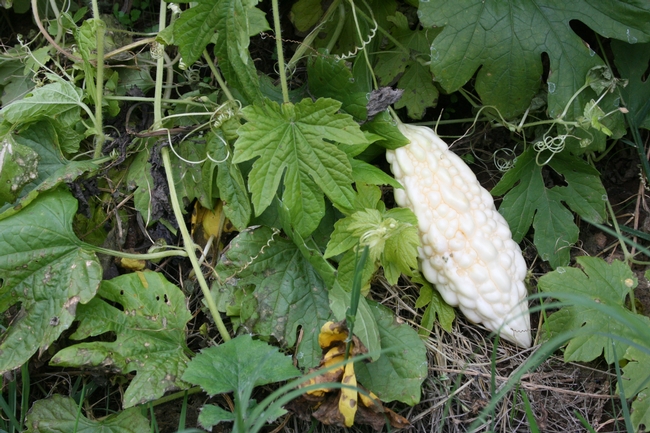Posts Tagged: Michael Yang
In person and over the airwaves, Yang strives to help Hmong farmers prosper
This is the third in a series featuring a few scientists whose work exemplifies UC ANR's public value for California.
Keeping current on government regulations, agricultural marketing news and crop research advances can be challenging for California farmers, especially for those who speak English as a second language.
Hmong farmers in the San Joaquin Valley can tune in at 2 p.m. on Tuesday afternoons to listen to farm-related news delivered to their radios in their native language from Michael Yang, UC Cooperative Extension small farms and specialty crops agricultural assistant for Fresno County.
For the past 22 years, Yang has hosted the one-hour Hmong Agriculture Radio Show on KBIF 900 AM in Fresno to promote prosperity in the largely immigrant, small-scale Southeast Asian farming community. Yang provides advice on crop production and marketing.
“Fresno County has a large number of small and diversified farms; we have over 1,300 Southeast Asian farms and over 900 are Hmong farmers, according to a survey we did in 2007,” Yang said. “I used to help 250 to 300 farmers every year, in the past couple of years it's grown to about 400 farmers.”
Yang not only speaks their language, he shares their culture and history. After his father was killed for assisting the U.S. during the Vietnam War, Yang, his mother and three younger brothers spent 4 years of his childhood fleeing on foot through the jungles of Laos, subsisting on vegetation and wildlife, to reach safety in Thailand. The refugee family eventually made it to Fresno, where they took up farming.
The Hmong farmers grow Asian specialty crops including eggplant, lemongrass, long bean, squashes, bittermelon and moringa that they sell at farmers markets or to restaurants. Connecting Southeast Asian farmers to sell their produce at farmers markets has been a vital role for Yang, who serves as a translator and cultural interpreter between the immigrant farmers and farmers market managers. He explains the requirements for participating in the farmers markets and helps the farmers with paperwork and communication. Some growers drive as far as San Diego to get a higher price for their produce; the price can be three times as high at farmers markets in larger cities compared to Fresno.
Sales of Asian specialty crops grown by Hmong and other Southeast Asian farmers in Fresno County are valued at about $17.5 million annually, according to the Agricultural Commissioner of Fresno County.
Although Yang and colleague Ruth Dahlquist-Willard, UC Cooperative Extension small farms advisor, offer workshops and field days to share information, the radio show is an important information source because farmers can listen to the show while they work in the field. Because Hmong Agriculture Radio Show is such a critical tool for bilingual outreach, Dahlquist-Willard continually seeks grants to pay the $75 per show to the radio station. Of the 69 Hmong farmers who responded to a 2015 UC Cooperative Extension survey, 80% said they regularly listened to Yang's radio show.
“With the help of our Hmong Agricultural radio outreach, I have Hmong farmers calling our office for assistance from Tulare County up to Stanislaus County,” Yang said.
In 2015, during the drought, Yang and Dahlquist-Willard began helping desperate farmers who were running out of irrigation water.
“Wells were starting to dry up. Some Hmong farmers were reportedly calling suicide hotlines,” Dahlquist-Willard recalled. “For the ones with dry wells, it could cost $20,000 to $50,000 to drill a new well.” That is money that most of the farmers, who typically cultivate less than 50 acres, didn't have.
Eighty-seven percent of the Hmong farmers said their utility bills had risen during the drought. Yang, Dahlquist-Willard and Xai Chang, a young Hmong farmer working with UCCE, helped the farmers get a free PG&E rate analysis, which could help the farmers choose the best electric rate for their irrigation practices to lower the expense. The UCCE team also searched for financing to deepen wells for farmers who had difficulty qualifying for USDA loans and helped them apply for grants from the State Water Efficiency and Enhancement Program. With additional help from small farms assistant Jacob Roberson, the UCCE small farms team in Fresno has assisted 36 small-scale Hmong, Latino, and African-American farmers to implement SWEEP projects on a total of 846 acres. The small-scale growers have used SWEEP dollars to invest in technologies like energy efficient pumps, drip irrigation systems and flow meters to save water and reduce their energy costs.
“Michael helped me get a grant to buy a new pump for drip irrigation,” said Xiong Pao Her, who grows about 100 crops throughout the year – including ginger, broccoli rabe, fennel, garlic, green onions, napa cabbage and kale – in Sanger. “It saves me water.”
Obtaining land to farm can be difficult for small-scale farmers so the UCCE agricultural assistant connects farmers looking to rent land with landowners, and serves as a bridge for the language and cultural gaps between the two, according to Dahlquist-Willard.
“There was an elderly couple and their daughter wanting to rent land to a Hmong family, and Michael sat down at the table with all the parties and helped them work out a lease agreement, such as requirements for liability insurance,” she said. “Land isn't as available to rent as it used to be, but when it was, Michael would get frequent calls from landowners asking if he knew any farmers who would be interested in renting their land. The number of Southeast Asian farmers who have had a successful lease agreement or a successful farmers market stand because of Michael's help is probably very large.”
Recently Yang and Dahlquist-Willard partnered with California State University Fresno to produce a pesticide-safety video series for the California Department of Pesticide Regulation. “We hope the videos help more farmers understand pesticide regulations and avoid fines, as well as improve their safe handling, selection and effectiveness,” said Yang.
It's not the first time Yang, who has been working for UC Cooperative Extension since 1993, has helped farmers navigate government regulations. Between 2005 and 2008, individual Hmong and Hispanic farmers were being fined between $14,000 and $26,000 for noncompliance with state labor regulations. To provide farmers with a clear understanding of the labor laws, Yang and Richard Molinar, then UCCE small farm advisor, partnered with a variety of community organizations to present information to farmers in English, Spanish, Lao and Hmong at community meetings, on the radio and television, and in trade magazines and newspapers.
“Without the support provided by the UCCE, hundreds, if not thousands, of Hmong farmers would have been added to the victim list for not knowing or understanding the laws. The UCCE has gone many extra miles to fill gaps between enforcement agencies and the Hmong farming community,” Toulu Thao, a Hmong activist, said at the time.
To help farmers decide which crops are most profitable to plant, Yang collaborated in the past with UC colleagues to estimate production costs for some Asian vegetables including sinqua, moqua, opo, longbean, bittermelon, oriental eggplant and lemongrass.
Yang currently advises Hmong growers on about 200 crops and continues to learn about new ones as farmers market customers ask the growers to produce fruits and vegetables from other cultures.
Fresno’s Southeast Asian farmers are on trend with new ‘superfood’
Farmer Vang Thao has been managing a successful farm south of Fresno for nearly 30 years, producing a spectacular array of vegetables – heirloom tomatoes, purple bell peppers, water spinach, bitter melon, Thai eggplant and dozens of others.
Every weekend the family traverses the Grape Vine to set up a visual feast at farmers markets in Santa Monica, Hollywood, Palos Verdes, Torrance and Hollywood. Acclaimed Los Angeles chefs rave about his produce, according to a Los Angeles Times feature story on the Thao family.
Produce like sweet potato leaves, amaranth and black nightshade are essential for families hailing from Vietnam, Laos, Thailand, the Philippines and India who seek ingredients for their traditional cuisine, but the market is limited. Now, small-scale farmers like the Thaos are on the cusp of something with much wider appeal.
One of their crops is moringa, a tropical tree that produces an abundance of fresh shoots to sell at the farmers market booth for $1 a bundle. Moringa is a delicate green that can be added to salads, soups and nearly any other dish. It has a pleasant nutty, earthy and slightly pungent green flavor. While it tastes good, it's the plant's nutrient profile that is commanding attention.
On the internet, moringas are called miracle trees. All parts of the plant are edible – the tender leaves can be cooked or eaten fresh, moringa flowers are considered a delicacy, the tree's young pods can be used like green beans, roasted seeds are said to have antibiotic and antifungal properties. The roots and bark have medicinal potential, but need more study to determine the right dose. A 100 gram serving of moringa greens has more protein than a cup of milk, more iron than a cup of spinach, and is high in calcium, potassium, vitamin C and vitamin A.
Moringa is the Superfood of 2018, according to the trend watchers at SPINS.com. UC Davis nutrition researcher Carrie Waterman is studying moringa's use, production and processing worldwide. She is pursuing moringa for therapeutic applications in treating cancer, HIV and inflammatory bowel disease.
Ruth Dahlquist-Willard, the UC Cooperative Extension advisor to small-scale farmers in Fresno and Tulare counties, recognized moringa's potential to supplement income for Southeast Asian farming families who are marketing specialty Asian vegetables and herbs to immigrant communities.
“Moringa is a drought tolerant tree known for its excellent nutritional content,” Dahlquist-Willard said. “We believe it could improve the economic viability of small-scale farms in our community. We are helping small-scale farmers with moringa product development and marketing.”
Supporting farmers growing moringa in marketing the product to new buyers is an objective of the UCCE moringa project, a partnership with the UC Sustainable Agriculture Research and Education Program, which was funded by a California Department of Food and Agriculture specialty crop block grant. Lorena Ramos, the project lead, is working on developing marketing materials, outreach opportunities, and value-added options.
While using moringa is second nature for many immigrant groups, expanding the market includes demonstrating how easily the green can be used in the kitchen. Dahlquist-Willard and Ramos called on another sector of UC Cooperative Extension – the UC CalFresh Nutrition Education Program – for assistance. UCCE offers nutrition education in schools and community settings to children and families eligible for the USDA's nutrition assistance programs. Each year, Fresno State dietetic students serve two-week internships at UCCE. In 2018, one of their tasks was developing creative, healthful recipes incorporating moringa. Among the recipes were overnight oatmeal, pesto, smoothies, guacamole and energy bites – all with moringa.
“We are publishing the best recipes to share with the public to help them add this nutritional green into their diets,” Ramos said.
Recipe cards and moringa samples will be available July 26 at the Fresno Food Expo, where UCCE is hosting a booth to raise awareness about moringa by introducing farmers to Fresno area chefs, buyers and consumers and sharing information about the vegetable's health benefits, culinary versatility and its ability support small-scale farmers in Fresno and Tulare counties.
Following is a USDA recipe ideal for incorporating moringa:
Grilled quesadilla with vegetables
Ingredients
Nonstick cooking spray
1 medium zucchini, diced
½ broccoli head, diced
1 green pepper, diced
1 medium onion, minced
1 carrot, peeled and grated
16 (6 inch) flour tortillas
12 ounces cheese, shredded
½ cup moringa leaves
Directions
- Wash all vegetables.
- Collect, dice, shred and measure all ingredients before starting to prepare the recipe.
- Spray a large skillet with cooking spray. Add zucchini, broccoli, green pepper, onion and carrot. Cook vegetables on medium heat for 4 to 5 minutes, stirring frequently. Remove vegetables from skillet, and put on a clean plate.
- Spray skillet with cooking spray again and place 1 tortilla in the skillet. Top with ½ cup vegetables and 1/3 cup cheese. Sprinkle on fresh moringa leaves.
- Place a second tortilla on top. Cook on medium low heat for 2 to 3 minutes or until the cheese starts to melt and the bottom tortilla starts to brown.
- Flip over the quesadilla. Cook for another 2 to 3 minutes until tortilla brons.
- Repeat steps 4 through 6 to make additional quesadillas
- Cut each quesadilla in half or quarters, serve hot with your favorite salsa or other toppings.
- Refrigerate leftovers within 2 hours. Eat within 3 to 5 days.
Farmers can increase income by expanding small operations with creative new businesses
Farms that sell only fresh produce are dependent on buyers for markets and pricing. The UC Cooperative Extension small farms team in Fresno and Tulare counties believes farmers can earn more money by taking production a step further, by adding extra value to their products with processing, preserving and packaging the produce.
UC Cooperative Extension small farms advisor Ruth Dahlquist-Willard, the UC Sustainable Agriculture Research and Education Program, and Fresno State's Office of Community and Economic Development brought a group of small farmers together for a workshop in January to learn about resources available to help them develop value-added businesses.
“Value-added products can improve the bottom line of a small family farm by bringing in additional income and diversifying production,” Dahlquist-Willard said. “We wanted to connect beginning farmers and Southeast Asian farmers to programs that could help them develop and market value-added products from their farms.”
The value-added workshop included presentations from a farmer with a successful value-added business, government agencies and non-profit organizations. Alternative lenders such as Fresno Madera Farm Credit, who provided funding for the workshop, also presented on loans available for small-scale farms. UCCE agricultural assistant Michael Yang translated the presentations into Hmong.
Kingsburg organic farmer Paul Buxman opened the workshop with his personal journey into value-added production. Buxman's story begins in 1994 when a spring hail storm swept through his farm.
“The hail marked all my fruit. I had 100,000 pounds of plums, peaches and nectarines I could not sell. What could I do?” Buxman said. “An idea came to my head like a lightbulb. Take the fruit, cut off the scar, cook it and make jam.”
The new venture wasn't an instant success. Buxman found himself delivering unsold jam that first year to a Bay Area homeless mission, pulling up right behind a bread truck.
“Man does not live by bread alone,” he said with a laugh.
But each year he and his wife improved their product, and the market grew.
“This jam is so addictive, it's barely legal,” Buxman said. His “Sweet Home Ranch Homemade Preserves” costs $2 per jar to make, and sells for $5 each.
Buxman suggested the farmers at the UCCE workshop to try making a value-added product. The new products could be spices, food, cleaning products, handicrafts, and even experiences, such a teaching a skill.
“You have so much more to offer people than you realize,” Buxman said.
During the subsequent panel discussion, Kiel Schmidt outlined the support that Food Commons Fresno can provide. An important element is the opportunity to rent the organization's commercial kitchen to create value-added merchandise to health department specifications. Patti Chang of Feed the Hunger Foundation said her organization provides technical assistance and loans to new ventures that can carry out their mission of reducing hunger and helping people out of poverty.
“We worked with two Oaxacan women in Madera who didn't want to be field workers anymore,” Chang said. “They wanted to make a product from their culture: mole. They became a certified business, opened a bank account at Wells Fargo and opened a small restaurant in a grocery story. We helped them negotiate the lease.”
Eduardo Gonzalez of Fresno State's San Joaquin Valley Rural Development Center said his facility can help small businesses with marketing, website design and getting value-added products to market.
Dawn Goliik of the U.S. Small Business Administration said the organization can help small farmers start, grow and run businesses with training, mentoring and counseling.
“It's all free to you,” Golik said.
The UCCE small farms team also has a marketing associate, Lorena Ramos, who is available for farmers to contact regarding value-added product development.
Presentations and one-on-one consultations were offered by a variety of organizations that can loan funds, including Fresno Madera Farm Credit, Access + Capital, Northern California Community Loan Fund, California FarmLink, USDA Farm Service Agency and Valley Small Business Development Corporation.
The workshop ended with a presentation on California's Cottage Food Law, which allows residents to process and prepare foods in their own home kitchens to sell to the public. Some of the home-prepared products the law permits are jams, jellies, cookies, cakes and fudge, dried fruit, vegetables and spices. A complete list of approved foods is on the state website.
The Cottage Food Law is for businesses with a gross annual income below $50,000, which have no more than one employee (not including household members).
“There is no charge, just paperwork to fill out,” said Matthew Gore with Fresno County Environmental Health. “This isn't difficult, and we're here to help you with the forms.”
Dahlquist-Willard said an important part of her UC Cooperative Extension program is the connections she and Yang can help farmers make with the myriad services available to them.
“We encourage small farmers to contact us in our Fresno office,” she said.
Contact information:
Ruth Dahlquist-Willard, (559) 241-7515, rdahlquistwillard@ucanr.edu
Michael Yang, (559) 241-7523, myang@ucanr.edu
Lorena Ramos, (559) 241-7524, mlramose@ucanr.edu
When vegetables become an adventure
Walking through a field lined with row upon row of different vegetables — many ready for the picking — can be an exercise in abundance. When you're faced with the prospects of a huge, just-picked Japanese cabbage or spicy green lo bok pulled fresh from the ground, suddenly vegetables might seem like less of a chore and more of an adventure.
I had a chance recently to visit Tchieng Farms with Richard Molinar and Michael Yang, both of UC Cooperative Extension Fresno County and the Small Farm Program. This pair has been part of the Great Veggie Adventure over the last several months along with the rest of the Small Farm Program team.
We were visiting the farm to share some new "veggie adventures" that went beyond the four colorful vegetables highlighted in this project (to refresh your memory, the Great Veggie Adventure highlighted Romanesco, rainbow carrots, party cauliflower and watermelon radishes).
Molinar and Yang showed me many vegetables I had never tried, including moqua, sinqua, long beans, lo bok, opo and winter melon.
"One of the exciting things about this job is you always learn something new," Molinar said. "Our specialty is with the Asian vegetables, with Michael's expertise in that area. Asians have vegetables that are unique to their culture, that they prefer — just like Punjabis have vegetables unique to their culture, and Hispanics have vegetables common to them."
We walked between the trellised crops and up and down the plant rows, while Yang and Molinar picked samples and talked about how to eat these new-to-me vegetables.
Yang pointed out that sometimes Asian vegetables include familiar varieties that are grown and eaten in less familiar ways. For example, many Hmong and Chinese farmers grow sugar snap pea plants for the tender shoots, tendrils and leaves instead of the pea pod.
Make sure to watch our short video from that day:
Still curious?
- Find more information about growing Asian vegetables from the UC Small Farm Program
- Visit the official Great Veggie Adventure website by the makers of Hidden Valley Salad Dressings
- Watch more videos from our Great Veggie Adventure playlist


